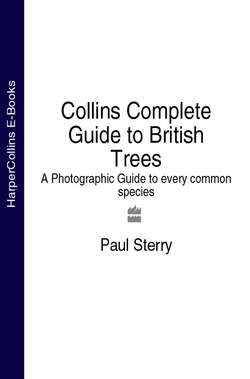Читать книгу Collins Complete Guide to British Trees: A Photographic Guide to every common species - Paul Sterry - Страница 20
GROWTH RINGS AND AGEING A TREE IN THE FIELD
ОглавлениеFor each year of its life a tree adds an internal ring of woody tissue to its trunk (see p.) and this leaves a permanent record of its age. Obviously, this record can be examined only if the tree is felled, or in some cases, if a fine core can be extracted from the bole, revealing a radial section of woody tissue. In some tree species growth rings can be difficult to discern and truly accurate ageing is best left to an expert dendrochronologist. However, ageing the cut stump of an oak, for example, is certainly not beyond the scope of the amateur naturalist, and a reasonable degree of accuracy can always be achieved.
Studying growth rings also provides a fascinating insight into the world of trees. In poor seasons fewer cells will be produced, so the final ring will not be as thick as one for a good growing season. This is a surprisingly accurate test of environmental conditions, as years in which there was known to be a summer drought, for example, can be shown to have narrower rings than warm and wet summers.
Examining cut stumps after forestry operations, measuring the circumference and counting the annual growth rings will give an idea of the age of trees of the same species of similar circumference. Other clues may help you to arrive at a reasonably accurate estimate of the tree’s age. Many conifers, like the larches, for example, produce a new set of shoots around the crown each year while, lower down, the oldest branches die off and fall away, leaving stumps around the bole. Each year’s growth produces a new ring of shoots around the main bole with a gap between them and the preceding year’s shoots. If the number of rings of old branch stumps low down is added to the number of rings of growing branches higher up, the sum will give a rough guide to the age of the tree.
The circumference of the bole does give a good guide to the tree’s age; however, for every species there is a point at which it reaches its optimum size. After that, it increases very slowly, if at all, gradually declining into old age. During the period of the tree’s maturity, however, it is fairly safe to assume that each 2.5cm of circumference represents one year of the tree’s life. This applies to normal healthy trees growing in places where they are free to attain their natural spread and height, unimpeded by other, neighbouring trees. It applies to most species of broadleaves and conifers growing in the open. Trees growing in woodland, with many other trees close by, will grow at only about half this rate, so before ageing a tree in this way, look at its surroundings, and at the crown and spread of the tree. Does it have a good-sized crown, or does it appear to be restricted in any way by other trees? If it appears to be growing normally with a good, healthy crown, then the 2.5cm-per-year rule can be applied.
Some trees are very slow-growing, so this rule cannot be applied to them. Yew, for example, grows at a rather pedestrian rate but is long-lived; in its old age it is so slow-growing that it hardly appears to increase in circumference at all. When using the circumference method of ageing a tree it is important to look for a vigorous and healthy tree in natural surroundings.
Close-up of annual growth rings of a Pedunculate Oak.
This Pedunculate Oak was around 184 years old when it was felled in the year 2000, as can be determined by counting the annual growth rings. Planted in the reign of George III, just after the end of the Napoleonic Wars, it saw the reigns of nine British monarchs, witnessed two World Wars and endured a globally significant climatic catastrophe.
